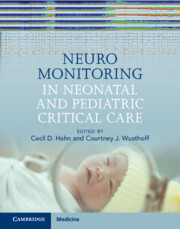Book contents
- Neuromonitoring in Neonatal and Pediatric Critical Care
- Reviews
- Neuromonitoring in Neonatal and Pediatric Critical Care
- Copyright page
- Contents
- Contributors
- Acknowledgements
- Part I General Considerations in Neuromonitoring
- Chapter 1 Overview of Continuous EEG Monitoring in Critically Ill Neonates and Children
- Chapter 2 Technical Aspects of Neurophysiological Monitoring
- Chapter 3 Logistics of Neuromonitoring
- Chapter 4 Nursing Considerations in Neuromonitoring
- Chapter 5 Normal Neurophysiology, Benign Findings, and Artifacts
- Chapter 6 Abnormal EEG in the Intensive Care Unit
- Part II Practice of Neuromonitoring: Neonatal Intensive Care Unit
- Part III Practice of Neuromonitoring: Pediatric Intensive Care Unit
- Part IV Practice of Neuromonitoring: Cardiac Intensive Care Unit
- Part V Cases
- Index
- References
Chapter 2 - Technical Aspects of Neurophysiological Monitoring
from Part I - General Considerations in Neuromonitoring
Published online by Cambridge University Press: 08 September 2022
- Neuromonitoring in Neonatal and Pediatric Critical Care
- Reviews
- Neuromonitoring in Neonatal and Pediatric Critical Care
- Copyright page
- Contents
- Contributors
- Acknowledgements
- Part I General Considerations in Neuromonitoring
- Chapter 1 Overview of Continuous EEG Monitoring in Critically Ill Neonates and Children
- Chapter 2 Technical Aspects of Neurophysiological Monitoring
- Chapter 3 Logistics of Neuromonitoring
- Chapter 4 Nursing Considerations in Neuromonitoring
- Chapter 5 Normal Neurophysiology, Benign Findings, and Artifacts
- Chapter 6 Abnormal EEG in the Intensive Care Unit
- Part II Practice of Neuromonitoring: Neonatal Intensive Care Unit
- Part III Practice of Neuromonitoring: Pediatric Intensive Care Unit
- Part IV Practice of Neuromonitoring: Cardiac Intensive Care Unit
- Part V Cases
- Index
- References
Summary
An electroencephalogram (EEG) reflects the summation of electrical activity arising from excitatory and inhibitory post-synaptic potentials of pyramidal neurons. EEG electrodes are traditionally placed on the scalp according to the International 10–20 system of electrode placement to reproducibly record cortical electrical activity. There are a number of different montages that may be used to best analyze an EEG, and allow for interpretation of the spatial distribution and localization of the EEG activity across the cortex. Neonates may require a reduced montage. Raw EEG data remain the gold standard of neurophysiological monitoring; however, reduced-montage and quantitative EEG techniques have allowed providers, particularly in the neonatal and pediatric intensive care units, to have supplementary data to interpret, in real time, at the patient’s bedside or via remote access. This chapter reviews the technical aspects of neurophysiological monitoring, including the practice and underlying principles of initiating, recording, displaying, and interpreting EEG. Quantitative trends, including CDSA and aEEG, are included.
- Type
- Chapter
- Information
- Neuromonitoring in Neonatal and Pediatric Critical Care , pp. 19 - 28Publisher: Cambridge University PressPrint publication year: 2022



